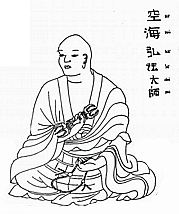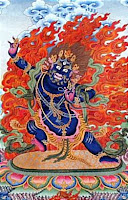 In this post I want to call attention to an important article, now over 15 years old, but with hardly any recognition outside academic circles. The article is:
In this post I want to call attention to an important article, now over 15 years old, but with hardly any recognition outside academic circles. The article is:Jan Nattier. 1992. The Heart Sūtra : a Chinese apocryphal text? Journal of the International Association of Buddhist Studies. Vol. 15 (2), p.153-223.
The editors of JIABS are in the process of digitising their back issues which will be available for free download. In the meantime they have graciously given me permission to offer the pdf to anyone who would like a copy. Click here.
The main argument of the article is that the Heart Sūtra was composed in China, incorporating some verses from the Chinese version of the Large Prajñāpāramita text, and back translated into Sanskrit sometime in the 7th century. Nattier also offers an explanation for the two different versions, one longer and one shorter, of the Heart Sūtra. Page references are to Nattier's article.
Nattier focuses initially on the shorter version of the Heart Sūtra. This has several problematic features which distinguish it from sūtras generally and the other Prajñāpāramita sūtras in particular. Firstly it does not begin with 'thus have I heard'; second there is is no audience reaction at the end of the sūtra; third the Buddha makes no appearance; fourth Avalokiteśvara, the bodhisattva of compassion makes an unexpected appearance, while the usual characters of Prajñāpāramita sūtras (such as Subhuti) do not; and lastly the sūtra contains a mantra, which few other Prajñāpāramita sūtras do, and then only the later tantric sūtras. Any explanation of the origin of the Heart Sūtra should provide some insights into these oddities, and Nattier's article does just this.
It has been known for centuries that the lines beginning with "form is not other than emptiness" and ending with "no knowledge and no attainment" are quoted from the Pañcaviṃśatisāhasrikā Prajñāpāramita Sūtra, or Perfection of Wisdom in 25,000 Lines (hereafter the Large Sūtra). The first reference to this borrowing is in a Chinese commentary from the 7th century. Nattier spends quite some space looking at the various versions of these verses. They occur in four places:
- Sanskrit Large Sūtra (using the oldest extant manuscript from Gilgit)
- Chinese Large Sūtra (trans. by Kumarajiva)
- Sanskrit Heart Sūtra (Conze's critical edition)
- Chinese Heart Sūtra (trans. Hsuan-tsung)
Sanskrit Large Sūtra : (na)anyad rūpam anyā śunyata / nānya śunyatānyad rūpa
Sanskrit Heart Sūtra : rūpān na pṛthak śunyatā / śunyatāyā na pṛthag rūpam
In the list of the nature of dharmas the Sanskrit Large Sūtra uses singular verbal forms, is more repetitious and slightly longer; while the Sanskrit Heart Sūtra uses plural adjectival forms, and is shorter and more succinct. Almost every word, barring some very well known technical terms such as śunyata, are different. Conze explains the differences in repetition as a process of summarising, however Nattier contends that this runs counter to the general Indian tendency to elaboration. In any case the changes in vocabulary are unprecedented and "there is no straight forward way to derive the Sanskrit Heart Sūtra from the Sanskrit Large Sūtra, or vice versa." (p.167)
The best way to understand the progression is that the verses moved from the Sanskrit Large Sūtra to the Chinese Large Sūtra, and thence into the the Chinese Heart Sūtra, and finally into the Sanskrit Heart Sūtra. Which is to say that it is far more plausible on philological grounds that the Sanskrit Heart Sūtra is a translation of the Chinese rather than the other way around.
Nattier proceeds to marshal supporting evidence for this conclusion beginning by considering known examples of back-translation - these are plentiful in Mongolian scriptures apparently. An important sign of back-translation is the choice of "unmatched but synonymous terms" (p.170). Also there may be occurrences of incorrect word order, grammatical errors point to the under lying language. In this case the evidence points to the Chinese Heart Sūtra as being a likely intermediary between the Sanskrit Large Sūtra and the Sanskrit Heart Sūtra: where the former has nirodha (extinction), the latter has kṣayo (destruction) while the Chinese Heart Sūtra has chin which can be a translation of either. This turns out to be true for each synonym in the Sanskrit texts.
Historical evidence also supports the argument. Indian commentaries cannot be dated to before the 8th century, while there is no independent evidence such as quotes in other texts which might place it earlier. By contrast Chinese commentaries are definitely dated in the 7th century, and "..the existence of the Heart Sūtra is attested in China at least a century before its earliest known appearance in India" (p.174)
However there are still some problems. In particular the Chinese were usually very particular when composing apocryphal texts, taking a lot of effort to make them look like Indian sūtras, and yet the Heart Sūtra clearly lacks many important features. Nattier cites a Japanese study (by FUKUI Fumimasa) which she says make a strong case for reconsidering the Chinese title of the Heart Sūtra : hsin ching. Fukui says this should be understood not as saying that the text is the heart, or essence of the Prajñāpāramita tradition, but rather represents a "dhāraṇī scripture", ie simply a text to be chanted. It is clear that this has indeed been the function of the text since its earliest mentions. The missing attributes (such as the 'thus have I heard') are less of a problem if we accept that the text is not even attempting to be a sūtra.
Most of the remaining problems occur in the portion of the text which surrounds the quoted verses - what Nattier calls "the frame". She seeks to show that it is plausible for the frame to have been composed in China. For instance the presence of Avalokiteśvara: this is quite consistent with devotional Buddhism in South West, 7th century China, and his presence is less surprising if the text is a devotional text for chanting rather than the essence of the Prajñāpāramita tradition. The presence of the mantra also marks out the Heart Sūtra as different. Nattier points out that the mantra is present in at least three other Chinese texts, and the epithets of the mantra also exist independently. (p.177). The point being that the presence of a mantra need not rule out a Chinese origin.
I think this is the only place where Nattier misses a trick. Donald Lopez, for instance, has commented on the lack of coherence between the mantra and the text.
"The question still remains of the exact function of the mantra within the sutra, because the sutra provides no such explanation and the sadhanas make only perfunctory references to the mantra". - Lopez. The heart sutra explained. p.120.The mantra is not of a piece with the sūtra, but appears to have been tacked on. Further Alex Wayman has noted that commentaries on the text lack coherence:
"The [commentators] seemed to be experiencing some difficulty in exposition, as though they were not writing through having inherited a tradition about the scripture going back to its original composition" - Secret of the Heart Sutra p.136This observations only strengthen the impression of a text appearing suddenly without a history of exegesis to be referred to. But, back to Nattier's article...
Another feature which supports the idea that the frame was written in China relates to phrases such as "satyam amithyavāt" which Conze translates as: "[It is] true. For what could go wrong". This is clearly an awkward phrase both in Sanskrit and in English translation. The Chinese - chen shih pu hsü or "genuine, not vain" - however is "entirely natural in Chinese". As Nattier says:
"The Heart Sūtra thus diverges from anticipated Sanskrit usage, offering instead a precise replication of the word order of the Chinese" (p.178)The final mystery is the existence of the two versions of the sūtra. The evidence is good that the short version was the one which was most prominent version in China. All of the extant Chinese commentaries are based on the Hsüan-tsang's (or Xuanzang) 'translation' of the short version. If we accept the idea that the sūtra was back-translated into Sanskrit after being composed in China, then the long version makes sense in the face of Indian criteria for authenticity - which include the appropriate opening, the presence of the Buddha, and the audience reaction to the discourse. The long version supplies all these features that are missing from the short version. From the Indian point of view the short version is not a sūtra at all - which fits with the idea that it was not intended to be one.
On purely philological grounds it seems that the Heart Sūtra was composed in China around the verses quoted from the Chinese version of the Pañcaviṃśatisāhasrikā Prajñāpāramita Sūtra. Internal textual evidence supports this conclusion, as do historical considerations. In short everything points in the direction of the 'Heart Sūtra' being a Chinese liturgical text which only became a sūtra on being back translated into Sanskrit, probably in India in the late 7th century. What is more, the most problematic features of the sūtra become comprehensible if we accept this view.
Nattier spends several pages exploring the role of Hsüan-tsang in the popularisation of the text: it was certainly a favourite of the pilgrim/translator, and he did know it before he left on his trip to India. It seems likely, though it is not proven, that it was Hsüan-tsung himself who introduced the text to India and translated it into Sanskrit when he discovered that the Indians lacked it. We know that exactly this happened in the case of another Chinese apocryphal text, the Awakening of Faith in the Mahāyāna, which he translated into Sanskrit during his stay at Nālandā.
To those amused, or perhaps alarmed, by this apparent forgery, Nattier points out that "it is now becoming clear that the Chinese were avid producers as well as consumers of Buddhist sūtras... and indeed evidence is accumulating for an important backwash of Chinese Buddhist influence into Central Asia" (p.181). Though the Heart Sūtra may be an apocryphal text:
"...this in no way undermines the value that the text has held for Buddhist practitioners. "Whatever is conducive to liberation" - so the Buddha is said to have told his followers - "that is my teaching"." (p.199)Nattier's article is a fantastic example of the kind of careful and exacting scholarship which marks her out. The conclusions are monumental, and yet eminently accessible. I highly recommend reading the article. Her work deserves a wider audience, and her conclusions should be informing our understanding of Buddhist history, both social and textual. One thing is clear from this, and her other publications, we Buddhists cannot afford to be fundamentalists when it comes to texts!


